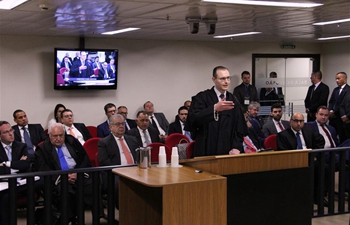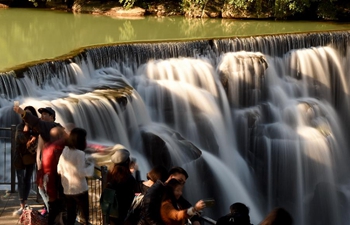
The colossus of ancient Egyptian King Ramses II is transferred to the Grand Egyptian Museum (GEM), about 2 km north the Great Pyramid of Giza, Egypt, Jan. 25, 2018. The Egyptian Ministry of Antiquities moved on Thursday the 3,200-year-old giant colossus of ancient Egyptian King Ramses II from its storage place at the under-construction Grand Egyptian Museum (GEM) to its atrium in preparation for the GEM soft opening later this year. (Xinhua/Ahmed Gomaa)
CAIRO, Jan. 25 (Xinhua) -- The Egyptian Ministry of Antiquities moved on Thursday the 3,200-year-old giant colossus of ancient Egyptian King Ramses II from its storage place at the under-construction Grand Egyptian Museum (GEM) to its atrium in preparation for the GEM soft opening later this year.
"The colossus of King Ramses II is the first artifact to be on display from the museum's treasured collection," said Antiquities Minister Khaled al-Anany.
Located some 2 km north of the Great Pyramid of Giza, on an area of 491,000 square meters, the GEM's soft opening is scheduled at the end of 2018. The grand opening is expected before the end of 2022.
"Until now, more than 70 percent of the museum construction works have been completed in preparation for its soft opening, the first phase, within 12 months," the minister added, noting that it will be the largest museum in the world that displays the artifacts of one civilization.
The moving process of King Ramses II colossus, covering a 400-meter distance, is carefully done by two heavy special vehicles amid a massive parade attended by officials from Egypt and other countries, archeologists, Egyptologists and diplomats.
The Ramses II colossus, with its 12-meter height and 80-ton weight, was discovered in 1820 in Giza and relocated in 1955 to a square in downtown Cairo later named after the ancient king's name.
It was later moved from the crowded Ramses Square to the GEM in 2006, four years after the foundation stone of the project was first laid in 2002.
The GEM accommodates 100,000 pieces of artifacts, 50,000 in constant display and the other 50,000 in modern storehouses for archeological studies and researches. Among the 50,000 pieces in future display, 30,000 will be exhibited for the first time.
"After completion within three years, the GEM is to exhibit a collection of 50,000 distinguished objects that were carefully selected from museums and archeological sites all over Egypt to show the different periods of the ancient Egyptian civilization," Anany said.
Thousands of artifacts have been moved to the GEM from the the Egyptian Museum in Tahrir downtown Cairo and other museums and archeological sites nationwide, including the 3,000-year-old funerary bed and chariot of famous ancient King Tutankhamun.
"The soft opening includes the atrium, the grand staircase and King Tutankhamun's galleries, stretching over more than 23,000 sqm, more than twice the size of the Egyptian Museum in Tahrir," he added.
The minister said that the grand staircase will display a collection of more than 87 real big statues and architectural elements such as huge segments of ancient temples, while King Tut's galleries will exhibit more than 5,000 of the king's artifacts on an area of over 7,000 sqm.
"The GEM is like a fourth pyramid in the Giza Plateau," he boasted.
Rich of monuments, Egypt has witnessed over the past year several big archaeological discoveries at different sites across the country, including Pharaonic tombs, statues, coffins, mummies and burial sites, remains of a Roman-style Hellenistic gymnasium, ruins of a funerary garden and a pyramid's burial chamber.















